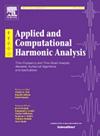A parameter-free two-bit covariance estimator with improved operator norm error rate
IF 3.2
2区 数学
Q1 MATHEMATICS, APPLIED
引用次数: 0
Abstract
A covariance matrix estimator using two bits per entry was recently developed by Dirksen et al. (2022) [11]. The estimator achieves near minimax operator norm rate for general sub-Gaussian distributions, but also suffers from two downsides: theoretically, there is an essential gap on operator norm error between their estimator and sample covariance when the diagonal of the covariance matrix is dominated by only a few entries; practically, its performance heavily relies on the dithering scale, which needs to be tuned according to some unknown parameters. In this work, we propose a new 2-bit covariance matrix estimator that simultaneously addresses both issues. Unlike the sign quantizer associated with uniform dither in Dirksen et al., we adopt a triangular dither prior to a 2-bit quantizer inspired by the multi-bit uniform quantizer. By employing dithering scales varying across entries, our estimator enjoys an improved operator norm error rate that depends on the effective rank of the underlying covariance matrix rather than the ambient dimension, which is optimal up to logarithmic factors. Moreover, our proposed method eliminates the need of any tuning parameter, as the dithering scales are entirely determined by the data. While our estimator requires a pass of all unquantized samples to determine the dithering scales, it can be adapted to the online setting where the samples arise sequentially. Experimental results are provided to demonstrate the advantages of our estimators over the existing ones.
一种改进算子范数错误率的无参数二位协方差估计器
Dirksen等人(2022)最近开发了一种协方差矩阵估计器,每个条目使用两个比特。对于一般的亚高斯分布,该估计器实现了接近极大极小算子范数率,但也存在两个缺点:理论上,当协方差矩阵的对角线仅由少数项占主导时,其估计器与样本协方差之间的算子范数误差存在本质差距;实际上,它的性能很大程度上依赖于抖动尺度,抖动尺度需要根据一些未知参数进行调整。在这项工作中,我们提出了一个新的2位协方差矩阵估计器,同时解决了这两个问题。与Dirksen等人中与均匀抖动相关的符号量化器不同,我们在受多位均匀量化器启发的2位量化器之前采用了三角形抖动。通过使用不同条目的抖动尺度,我们的估计器具有改进的算子范数错误率,该错误率取决于底层协方差矩阵的有效秩,而不是环境维度,这是最优的,直到对数因子。此外,我们提出的方法不需要任何调优参数,因为抖动尺度完全由数据决定。虽然我们的估计器需要通过所有未量化的样本来确定抖动尺度,但它可以适应样本顺序出现的在线设置。实验结果证明了我们的估计器相对于现有估计器的优越性。
本文章由计算机程序翻译,如有差异,请以英文原文为准。
求助全文
约1分钟内获得全文
求助全文
来源期刊

Applied and Computational Harmonic Analysis
物理-物理:数学物理
CiteScore
5.40
自引率
4.00%
发文量
67
审稿时长
22.9 weeks
期刊介绍:
Applied and Computational Harmonic Analysis (ACHA) is an interdisciplinary journal that publishes high-quality papers in all areas of mathematical sciences related to the applied and computational aspects of harmonic analysis, with special emphasis on innovative theoretical development, methods, and algorithms, for information processing, manipulation, understanding, and so forth. The objectives of the journal are to chronicle the important publications in the rapidly growing field of data representation and analysis, to stimulate research in relevant interdisciplinary areas, and to provide a common link among mathematical, physical, and life scientists, as well as engineers.
 求助内容:
求助内容: 应助结果提醒方式:
应助结果提醒方式:


